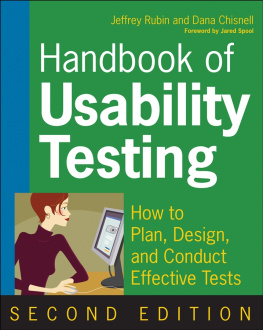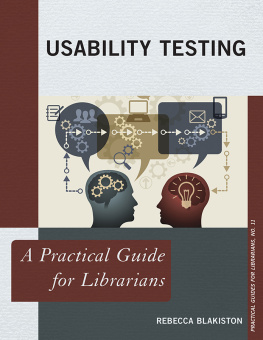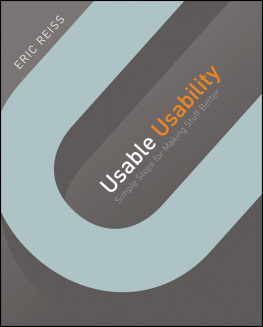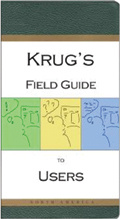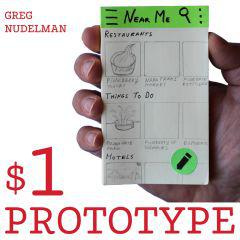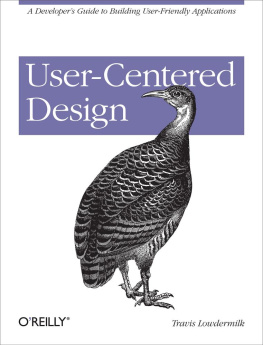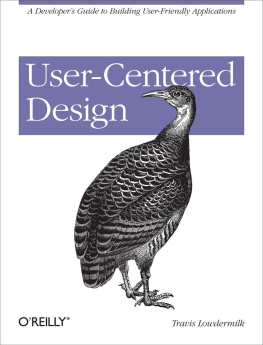Handbook of Usability Testing, Second Edition: How to Plan, Design, and Conduct Effective Tests
Published by
Wiley Publishing, Inc.
10475 Crosspoint Boulevard
Indianapolis, IN 46256
Copyright 2008 by Wiley Publishing, Inc., Indianapolis, Indiana
Published simultaneously in Canada
ISBN: 978-0-470-18548-3
No part of this publication may be reproduced, stored in a retrieval system or transmitted in any form or by any means, electronic, mechanical, photocopying, recording, scanning or otherwise, except as permitted under Sections 107 or 108 of the 1976 United StatesCopyright Act, without either the prior written permission of the Publisher, or authorization through payment of the appropriate per-copy fee to the Copyright Clearance Center, 222 Rosewood Drive, Danvers, MA 01923, (978) 750-8400, fax (978) 646-8600. Requests to the Publisher for permission should be addressed to the Legal Department, Wiley Publishing, Inc., 10475 Crosspoint Blvd., Indianapolis, IN 46256, (317) 572-3447, fax (317) 572-4355, or online at http://www.wiley.com/go/permissions.
Limit of Liability/Disclaimer of Warranty: The publisher and the author make no representations or warranties with respect to the accuracy or completeness of the contents of this work and specifically disclaim all warranties, including without limitation warranties of fitness for a particular purpose. No warranty may be created or extended by sales or promotional materials. The advice and strategies contained herein may not be suitable for every situation. This work is sold with the understanding that the publisher is not engaged in rendering legal, accounting, or other professional services. If professional assistance is required, the services of a competent professional person should be sought. Neither the publisher nor the author shall be liable for damages arising herefrom. The fact that an organization or Website is referred to in this work as a citation and/or a potential source of further information does not mean that the author or the publisher endorses the information the organization or Website may provide or recommendations it may make. Further, readers should be aware that Internet Websites listed in this work may have changed or disappeared between when this work was written and when it is read.
For general information on our other products and services or to obtain technical support, please contact our Customer Care Department within the U.S. at (800) 762-2974, outside the U.S. at (317) 572-3993 or fax (317) 572-4002.
Library of Congress Cataloging-in-Publication Data is available from the publisher.
Trademarks: Wiley, the Wiley logo, and related trade dress are trademarks or registered trademarks of John Wiley & Sons, Inc. and/or its affiliates, in the United States and other countries, and may not be used without written permission. All other trademarks are the property of their respective owners. Wiley Publishing, Inc. is not associated with any product or vendor mentioned in this book.
Wiley also publishes its books in a variety of electronic formats. Some content that appears in print may not be available in electronic books.
Dedicated to those for whom usability and user-centered design is a way of life and their work a joyful expression of their genuine concern for others.
Jeff
To my parents, Jan and Duane Chisnell, who believe me when I tell them that I am working for world peace through user research and usability testing.
Dana
About the Authors
Jeff Rubin has more than 30 years experience as a human factors/usability specialist in the technology arena. While at the Bell Laboratories' Human Performance Technology Center, he developed and refined testing methodologies, and conducted research on the usability criteria of software, documentation, and training materials.
During his career, Jeff has provided consulting services and workshops on the planning, design, and evaluation of computer-based products and services for hundreds of companies including Hewlett Packard, Citigroup, Texas Instruments, AT&T, the Ford Motor Company, FedEx, Arbitron, Sprint, and State Farm. He was cofounder and managing partner of The Usability Group from 19992005, a leading usability consulting firm that offered user-centered design and technology adoption strategies. Jeff served on the Board of the Usability Professionals Association from 19992001.
Jeff holds a degree in Experimental Psychology from Lehigh University. His extensive experience in the application of user-centered design principles to customer research, along with his ability to communicate complex principles and techniques in nontechnical language, make him especially qualified to write on the subject of usability testing.
He is currently retired from usability consulting and pursuing other passionate interests in the nonprofit sector.
Dana Chisnell is an independent usability consultant and user researcher operating UsabilityWorks in San Francisco, CA. She has been doing usability research, user interface design, and technical communications consulting and development since 1982.
Dana took part in her first usability test in 1983, while she was working as a research assistant at the Document Design Center. It was on a mainframe office system developed by IBM. She was still very wet behind the ears. Since then, she has worked with hundreds of study participants for dozens of clients to learn about design issues in software, hardware, web sites, online services, games, and ballots (and probably other things that are better forgotten about). She has helped companies like Yahoo!, Intuit, AARP, Wells Fargo, E*TRADE, Sun Microsystems, and RLG (now OCLC) perform usability tests and other user research to inform and improve the designs of their products and services.
Dana's colleagues consider her an expert in usability issues for older adults and plain language. (She says she's still learning.) Lately, she has been working on issues related to ballot design and usability and accessibility in voting.
She has a bachelor's degree in English from Michigan State University. She lives in the best neighborhood in the best city in the world.
Credits
Executive Editor
Bob Elliott
Development Editor
Maureen Spears
Technical Editor
Janice James
Production Editor
Eric Charbonneau
Copy Editor
Foxxe Editorial Services
Editorial Manager
Mary Beth Wakefield
Production Manager
Tim Tate
Vice President and Executive Group Publisher
Richard Swadley
Vice President and Executive Publisher
Joseph B. Wikert
Project Coordinator, Cover
Lynsey Stanford
Proofreader
Nancy Bell
Indexer
Jack Lewis
Cover Image
Getty Images/Photodisc/McMillan Digital Art
Acknowledgments
From Jeff Rubin
From the first edition, I would like to acknowledge:
- Dean Vitello and Roberta Cross, who edited the entire first manuscript.
- Michele Baliestero, administrative assistant extraordinaire.
- John Wilkinson, who reviewed the original outline and several chapters of the manuscript.
- Pamela Adams, who reviewed the original outline and most of the manuscript, and with whom I worked on several usability projects.
- Terri Hudson from Wiley, who initially suggested I write a book on this topic.
- Ellen Mason, who brought me into Hewlett Packard to implement a user-centered design initiative and allowed me to try out new research protocols.
For this second edition, I would like to acknowledge:
- Dave Rinehart, my partner in crime at The Usability Group, and co-developer of many user research strategies.

